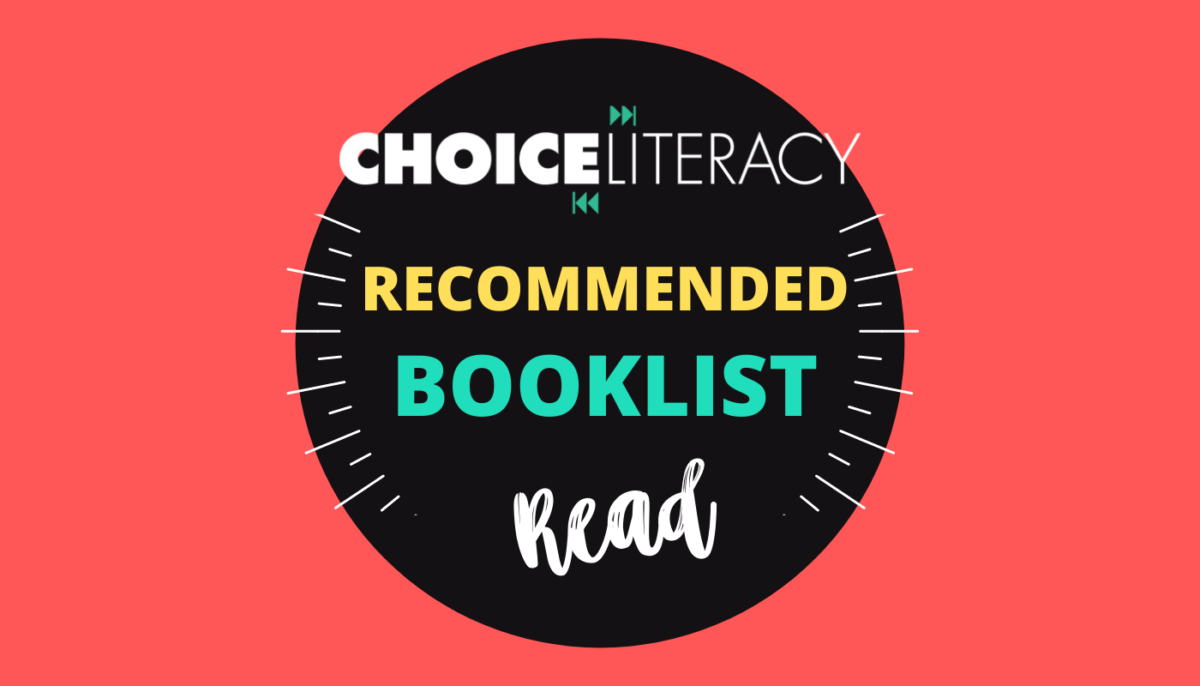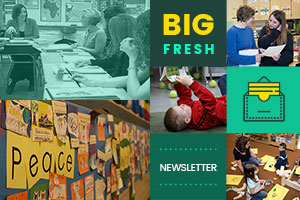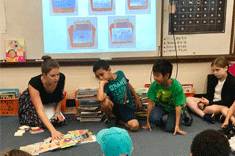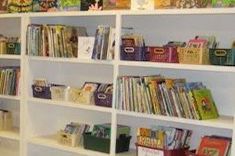Library
Choice Literacy Articles & Videos
The Choice Literacy library contains over 3,000 articles and 900 videos from 150+ contributors. Classic Classroom and Literacy Leadership subscribers have access to the entire library. Content is updated continuously, with five to six new features published each week.
Latest Content
Literary Salons: Book Clubs, Elevated
Inspired by the 17th-century popularity of literary salons, Gretchen Schroeder changed the usual book club routine for her high school students. Literary salons allow people to explore big topics and ideas together without reading the same book. They can create engaging discussions, expose students to new ideas and books, and give them the chance to learn from one another in a relaxed way.
How to Promote Civil Discourse in Your Classroom
Matt Renwick shows how to build the capacity of all students to engage in civil discourse.
Navigating the Election Season Booklist
Mandy Robek shares a booklist inspired to give students background about U.S. presidential elections.
Putting Political Talk into Perspective
Gretchen Schroeder encourages teachers to help students know how to talk politics by establishing a positive mindset and attitude when approaching conversations.
October 18, 2024: Learning to Collaborate
This week’s newsletter is about helping students learn to share ideas.
Patterns of Prompting
We spend our days prompting whole groups, small groups, and individual learners. We’ve all been in situations where we may not have known what to say. Melissa Quimby offers advice on how to be educators who use language brimming with curiosity and encouragement.
Vertical Whiteboards
Tammy Mulligan shares how vertical whiteboards are a powerful tool to support collaboration and make student thinking visible.
October 11, 2024: A Community of Readers
This week’s newsletter is about building a reading community.
Indoor Walks
Gigi McAlister discovered that using indoor walks is a way to help students engage in their learning and strengthen their learning community through conversations.
Pick One: How to Establish a Community of Readers
“Pick one!” These are the words that begin to grow a community of readers. When students say, “I’m done,” Becca Burk points toward the classroom library and encourages them to pick a book and begin growing strong roots as a reader.
October 4, 2024: A Love of Books
This week’s newsletter is about the power of learning to love books.
September 27, 2024: No Struggle, No Story
This week’s newsletter is about planning narratives.
Reclaiming Space: Weeding to Grow a Healthy Library
Books, like gardens, need to be tended to regularly for the whole library to thrive. Gigi McAllister gives tips for anyone in the weeding process for their school or classroom library.
You Know How to Show Them
Becca Burk tackles the issues associated with distraction when it comes to helping students engage with a book rather than a device.
September 20, 2024: Tough Ones
This week’s newsletter is about small connections that make a big difference.
I Don’t Hate Graphic Organizers
Vivian Chen challenges us to replace an overly prescriptive handout that dictates the contents of a paragraph or essay with more open-ended organizers and exemplars to help students plan and write with more independence.
Bit by Bit: Lifting the Level of Storytelling
Melissa Quimby shifts the way she helps students approach narrative writing by focusing on the conflict and encouraging students to unfold it bit by bit. This small shift lifts the level of the stories students write—you can try it, too!
Responding to Dysregulated Behavior: How to Move Forward
Becca Burk shares how to move forward in healthy ways after the extreme situation of a student dislocating her knee. This is the final installment of a four-part series chronicling the responses when a student with dysregulated behaviors joins Becca’s kindergarten class mid-year.
My Student Is Risk Averse
Molly James explains the difference between shyness and risk aversion.
September 13, 2024: Create Space
This week’s newsletter is about protecting time and space for learning.
Morning Hike
Gwen Blumberg helps us consider and create space for a variety of personalities and learning needs. Inspired by a morning hike, she takes her observations and applies them to give space for all students to learn.
Responding to Dysregulated Behaviors: What about the other kids?
Becca Burk reflects on the other kids in the classroom who witness dysregulated behaviors from a classmate. She reminds us of the way grace and acceptance are prominent when we look for the silver linings in difficult situations. This is the third installment of a four-part series chronicling the responses when a student with dysregulated behaviors joins Becca Burk’s kindergarten class mid-year.
September 6, 2024: Beginning a New School Year
This week’s newsletter is about beginning a new school year.
August 30, 2024: Belonging
This week’s newsletter is about belonging.
Responding to Dysregulated Behaviors: A Symptom of What?
When a new student spirals into anxiety and becomes aggressive, Becca Burk finds herself with a dislocated knee and advocating for the student to return to the classroom. This is the second installment of a four-part series chronicling the responses when a student with dysregulated behaviors joins Becca Burk’s kindergarten class mid-year.
A Poetic Beginning
Tara Barnett and Kate Mills use poetry to help students discover writing ideas. Inspired by three poems, students share their notebook entries and poems from the first days of a new school year.
Let’s Begin
Gwen Blumberg reflects on the community developed at a writing retreat and encourages teachers to consider the community of learners they will intentionally nourish this school year.
Responding to Dysregulated Behaviors: “What’s a Book?”
When a new student joins Becca Burk’s kindergarten classroom and asks, “What’s a book?” Becca realizes some behaviors are new to even the most veteran teachers. This is the first installment of a four-part series chronicling the responses when a student with dysregulated behaviors joins Becca Burk’s kindergarten class mid-year.
Do I Belong?
Tammy Mulligan considers ways to help students feel and know that they belong in the classroom community. The more we broaden our knowledge of others, and discover more about who we are and what we care about, the more our sense of belonging can grow.
August 23, 2024: Becoming a Reader
This week’s newsletter is about becoming a wholehearted reader.
Browse Content By
Type
Category
- Assessment Tools
- Big Fresh Archives
- Booklists
- Choice Numeracy
- Classroom Design
- Common Core
- Community Building
- Conferring
- Content Literacy
- Digital Literacy
- English Language Learners
- Equity
- Family Relations
- Free Samples
- Guiding Groups
- Leadership
- Literacy Coaches
- Mentor Texts
- Minilessons
- New Teacher Mentors
- Podcasts
- Poetry
- Quote Collections
- Reading Strategies
- Self Care
- Struggling and Striving Learners
- Talking and Listening
- Teacher Study Groups
- Teaching Reading
- Teaching Writing
- Word Study and Vocabulary
Author
- Melissa Quimby
- Nawal Qarooni
- Gwen Blumberg
- Julie Cox
- The Lead Learners
- Hannah Tills
- Josie Stewart
- Ruth Metcalfe
- Mallory Messenger
- Becca Burk
- Jodie Bailey
- Vivian Chen
- Mary Brower
- Tiffany Abbott Fuller
- Stephanie Affinito
- Ruth Ayres
- Leigh Anne Eck
- Heather Fisher
- Shari Frost
- Julie Johnson
- Suzy Kaback
- Gigi McAllister
- Shirl McPhillips
- Melanie Meehan
- Cathy Mere
- Debbie Miller
- Tara Barnett and Kate Mills
- Tammy Mulligan
- Dana Murphy
- Bitsy Parks
- David Pittman
- Brenda Power
- Heather Rader
- Matt Renwick
- Mandy Robek
- Christy Rush-Levine
- Gretchen Schroeder
- Jen Schwanke
- Brian Sepe
- Katherine Sokolowski
- Stella Villalba
- Jennifer Vincent
Grade Level
Choice Literacy Membership
Articles
Get full access to all Choice Literacy article content
Videos
Get full access to all Choice Literacy video content
Courses
Access Choice Literacy course curriculum and training



















